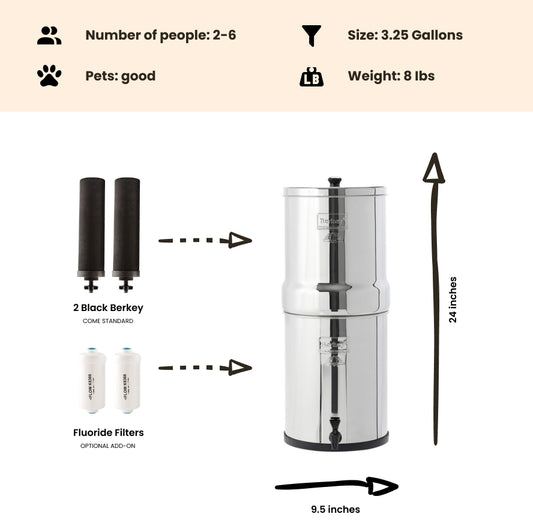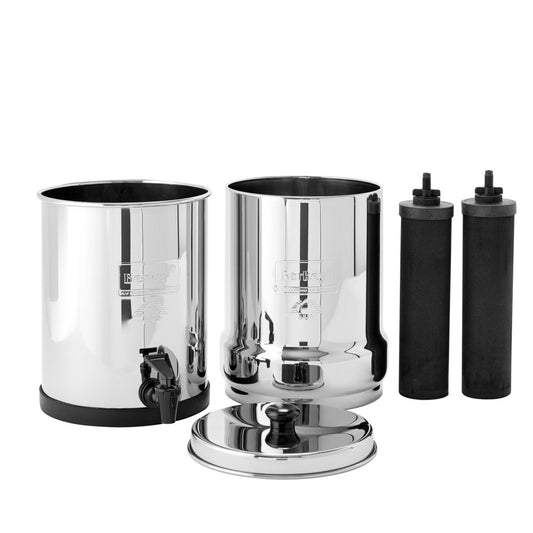
Environmental Exposure to Growth Hormones used in Beef Production Higher than expected
By Dan DeBaunShare
A recent study conducted by an environmental scientist at Indiana University together with colleagues from universities in Washington and Iowa has found that growth hormones used in agriculture, that are potentially harmful to the environment and to human health, can persist in natural systems at higher levels and for longer periods than initially thought.
Note: Yes, the Berkey Water Filter has been tested to remove hormones from drinking water. Progesterone and BPA have been shown to be removed by over 99.5%."What we release into the environment is just the starting point for a complex series of chemical reactions that can occur, sometimes with unintended consequences," said Adam Ward, lead author of the study and assistant professor in the IU Bloomington School of Public and Environmental Affairs. "When compounds react in a way we don't anticipate -- when they convert between species, when they persist after we thought they were gone -- this challenges our regulatory system."
The numerical modeling performed during the study can assist scientists with predicting potential effects of environmental processes on the fate of contaminants to enable them to better understand, and thus anticipate any unexpected effects.
This research highlights potential flaws in the system for regulating hazardous materials in the US, which currently tends to focus on individual compounds, while typically failing to take complex and often unexpected chemical reactions that may occur when these compounds interact with other elements and compound in the environment into account.
The study, which was recently published in Nature Communications, looks at the environmental fate of the contaminant trenbolone acetate (TBA), a potent synthetic hormone that mimics testosterone, which is used to promote growth in cattle raised for beef. TBA is inserted into the ears of cattle, which when metabolized producers the endocrine disruptor, 17-alpha-trenbolone, which has a similar chemical composition to TBA. This metabolite is excreted and can contaminate waterways when manure is washed into freshwater systems or when it is used to fertilize crops. Most of the beef cattle farmed in the US are given growth hormones such as TBA to encourage weight gain.
TBA and its associated byproducts represent examples of 'emerging contaminants' that are of growing concern. These contaminants are endocrine disruptors that have been shown to be capable of disrupting the reproductive systems and reproductive behavior of aquatic organisms.
Because the compound breaks down quickly in the presence of sunlight, it was initially believed that the environmental risk was low. However a recent study has shown that the byproducts revert back to 17-alpha-trenbolone when darkness falls, meaning that the compound is only temporarily removed when exposed to sunlight, and can persist in streams, returning to its original form at night, or in the shadows of murky waters, and in areas of the streambed where groundwater and stream water mix.
Using mathematical models, the researchers show that TBA metabolite levels may be around 35% higher in water bodies than initially thought, and because they persist for longer, the levels of biological exposure are likely to be 50% higher than originally anticipated. According to Ward, that is a problem, because these compounds are potent endocrine disruptors that are known to have significant impacts on aquatic life even at low concentrations.
"These compounds have the potential to disrupt entire ecosystems by altering reproductive cycles in many species, including fish," Ward said. "We expect impacts that extend through the aquatic food web."
Studies conducted by the USGS and others have shown that endocrine disruptors are not only present in freshwater systems, but can also contaminate drinking water sources. While the focus of this study was TBA and its byproducts, according to Ward, these compounds represent many others, suggesting that a new approach to the regulation of hazardous substances may be needed to maintain environmental integrity and safe drinking water.
"Our focus on individual compounds has been highly successful in getting us where we are today, which is some of the cleanest water in the world," said Ward. "The next step is thinking about unexpected reactions that occur in the environment and how we can manage the diverse group of potential products and their joint effect on the environment and human health."Journal Reference: Adam S. Ward, David M. Cwiertny, Edward P. Kolodziej, Colleen C. Brehm. Coupled reversion and stream-hyporheic exchange processes increase environmental persistence of trenbolone metabolites. Nature Communications, 2015; 6: 7067 DOI: 10.1038/ncomms8067
-
Regular price $234.00 USDRegular priceUnit price / per
-
Regular price $327.00 USDRegular priceUnit price / per
-
Regular price From $367.00 USDRegular priceUnit price / per
-
Regular price From $408.00 USDRegular priceUnit price / per
-

 Sold outRegular price From $451.00 USDRegular priceUnit price / per
Sold outRegular price From $451.00 USDRegular priceUnit price / per -
Regular price From $478.00 USDRegular priceUnit price / per
-
Regular price $332.50 USDRegular priceUnit price / per
$350.00 USDSale price $332.50 USDSale

Dan DeBaun is the owner and operator of Big Berkey Water Filters. Prior to Berkey, Dan was an asset manager for a major telecommunications company. He graduated from Rutgers with an undergraduate degree in industrial engineering, followed by an MBA in finance from Rutgers as well. Dan enjoys biohacking, exercising, meditation, beach life, and spending time with family and friends.
~ The Owner of Big Berkey Water Filters















